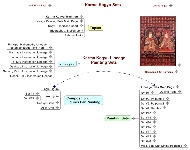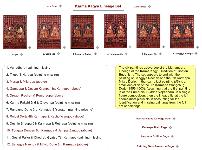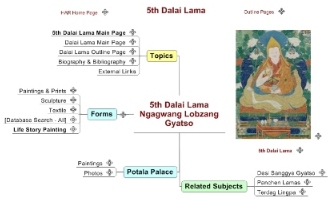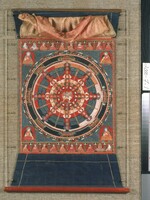 A unique characteristic of Himalayan style art is the creation of painting and sculpture sets as a single large composition. A second unique feature of Himalayan art is the creation of Incarnation Lineage paintings and painting sets. The notion of the same recognized human or living entity, such as the Dalai Lama, knowingly inhabiting a series of bodies through numerous generations is unique to Tibetan and Himalayan Buddhism. Therefore, Incarnation Lineage paintings and sculpture sets are a unique feature of Himalayan & Tibetan Style Art.
A unique characteristic of Himalayan style art is the creation of painting and sculpture sets as a single large composition. A second unique feature of Himalayan art is the creation of Incarnation Lineage paintings and painting sets. The notion of the same recognized human or living entity, such as the Dalai Lama, knowingly inhabiting a series of bodies through numerous generations is unique to Tibetan and Himalayan Buddhism. Therefore, Incarnation Lineage paintings and sculpture sets are a unique feature of Himalayan & Tibetan Style Art.
Fortunately for the purposes of study a number of the important incarnation lineages fall into natural groupings. The first group is concerned with the first recognized, or accepted, incarnate lama of Tibet, commonly said to be the Gyalwa Karmapa. Within the over-all tradition of the Karmapas, the Karma Kagyu Tradition of Tibetan Buddhism, there are also the incarnate lineages of Shamar, Situ, Gyaltsab and Nenang Pawo. These five lineages of incarnations all belong to the same religious tradition and naturally form there own group. According to tradition, added to those are the Karma Tinlepa and the Treho Tulku although so far no painting or sculpture sets have been found that depict the two unique additional incarnation lineages.
The second important group is that of the Dalai Lama, Panchen Lama and Desi Sanggye Gyatso. The foundations for these incarnation lineages were developed at the same time in the 17th century and seemingly as a coherent inter-connecting group of three with each incarnation in a generation relating directly with the other incarnations. Examples of this inter-relationship are the Panchen Lama pre-incarnation of Atisha and the Dalai Lama pre-incarnation of the student Dromton. At the time of the 4th Dalai Lama the Desi pre-incarnation was Altan Khan who first used and offered the title 'Dalai Lama.'
Another natural group related in life and in incarnation lineage is Jamyang Kyentse Wangpo and Jamgon Kongtrul Lodro Taye.
In each composition that depicts a complete incarnation lineage the central figure is surrounded by the previous incarnations. The earliest of these pre-incarnations for each central subject is almost always an Indian Adept (mahasiddha), a great Worthy One (arhat), or a bodhisattva such as Maitreya as with the Tai Situ incarnation lineage. Each of these originating pre-incarnations is a direct student of Shakyamuni Buddha.
Sometimes there are competing systems for enumerating and naming the former births. One such notable figure that has two variant lists, or an abbreviated list and a long list, is the Panchen Lama of Tibet. The long list of Panchen Lama pre-incarnations includes Padmasambhava and Jowo Atisha. The Dalai Lama list includes King Trisong Detsen and Dromton. The 8th Tai Situ of the Karma Kagyu Tradition apparently also claimed to be the re-incarnation of Taranata from a completely separate unrelated incarnation lineage system belonging to the Jonang Tradition of Tibetan Buddhism. The 32nd Sakya Tridzin Wangdu Nyingpo also boasts Padmasambhava as a pre-incarnation and claims to be the 2nd Padmasambhava of this 'age.' Both the Gelug Longdol Lama and the Karma Kagyu Tai Situpa claim to have the pre-incarnations of both Dombi Heruka and Marpa Chokyi Lodro in common.
The incarnation lineages, names and groups of related figures discussed here are only those that have identifiable works of art depicting those individuals. There are hundreds of other incarnation lineages in Tibetan and Himalayan Buddhism. It is possible that many of the paintings of Lamas that are currently unidentified are actually incarnation lineage paintings.
Incarnation Lineages Outline Page
Google Tags: Himalayan Art Resources
 The Five forms of Tsongkapa (je zigpa nga den) are based on the visions of Kedrub Geleg Pal Zangpo (1385-1438) of his teacher Tsongkapa (1357-1419).
The Five forms of Tsongkapa (je zigpa nga den) are based on the visions of Kedrub Geleg Pal Zangpo (1385-1438) of his teacher Tsongkapa (1357-1419).


















